Monacor HSE-90 Handleiding
Bekijk gratis de handleiding van Monacor HSE-90 (2 pagina’s), behorend tot de categorie Microfoon. Deze gids werd als nuttig beoordeeld door 29 mensen en kreeg gemiddeld 4.6 sterren uit 15 reviews. Heb je een vraag over Monacor HSE-90 of wil je andere gebruikers van dit product iets vragen? Stel een vraag
Pagina 1/2

ELECTRONICS FOR SPECIALISTS ELECTRONICS FOR SPECIALISTS ELECTRONICS FOR SPECIALISTS ELECTRONICS FOR SPECIALISTS ELECTRONICS FOR SPECIALISTS ELECTRONICS
HSE-90
Bestell-Nr. • Order No. 23.4070
MONACOR INTERNATIONAL GmbH & Co. KG • Zum Falsch 36 • 28307 Bremen • Germany
Copyright© by MONACOR INTERNATIONAL. All rights reserved. A-0397.99.02.11.2018
Microphone serre-tête
Cette notice s’adresse aux utilisateurs sans
connaissances techniques particulières. Veuil-
lez lire la présente notice avant le fonction-
nement et conservez-la pour pouvoir vous y
reporter ultérieurement.
1 Possibilités d’utilisation
Le microphone serre-tête HSE-90 est idéalement
adapté pour des applications de discours et de chant
requérant une grande liberté de mouvements. Pour
le fonctionnement, un adaptateur d’alimentation
(p. ex. EMA-1 ou EMA-300P) ou un émetteur de
poche (TXS-…HSE) pour la transmission audio sans
fil est en plus nécessaire.
2 Conseils importants
Le microphone répond à toutes les directives néces-
saires de l’Union européenne et porte donc le sym-
bole
.
•
Le microphone n’est conçu que pour une utilisa-
tion en intérieur. Protégez-le de tout type de pro-
jections d’eau, des éclaboussures, d’une humidité
élevée et de la chaleur (plage de température de
fonctionnement autorisée : 0 – 40 °C).
•
Pour le nettoyer, utilisez uniquement un chiffon
sec et doux, en aucun cas de produits chimiques
ou d’eau.
•
Nous déclinons toute responsabilité en cas de dom-
mages matériels ou corporels résultants si le micro-
phone est utilisé dans un but autre que celui pour
lequel il a été conçu, s’il n’est pas correctement bran-
ché ou s’il n’est pas réparé par une personne ha-
bilitée; en outre, la garantie deviendrait caduque.
Lorsque le microphone est définitivement
retiré du service, vous devez le déposer
dans une usine de recyclage adaptée
pour contribuer à son élimination non
polluante.
CARTONS ET EMBALLAGE
PAPIER À TRIER
3 Fonctionnement
1) Mettez le microphone serre-tête et positionnez
la capsule micro près de la bouche dans une
position favorable pour parler. Pour ce faire, le
bras de micro peut être bougé dans toutes les
directions.
2) Reliez la prise mini XLR du cordon micro à la prise
d’entrée de l’émetteur de poche ou de l’adapta-
teur d’alimentation. Si vous utilisez un adapta-
teur d’alimentation, reliez-le à une en trée micro
d’un appareil audio.
4 Caractéristiques techniques
Type micro : . . . . . . . . . back électret
Caractéristique : . . . . . cardioïde
Bande passante : . . . . . 20 – 20 000 Hz
Impédance : . . . . . . . . 650 kΩ
Sensibilité : . . . . . . . . . 10 mV/ Pa à 1 kHz
Pression sonore max. : 120 dB
Alimentation :. . . . . . . ⎓ 1,5 – 9 V par adaptateur
alimentation ou émet-
teur de poche
Poids : . . . . . . . . . . . . . 25 g
Connexion : . . . . . . . . . cordon 1,1 m avec
prise mini XLR 3 pôles
2
3 1 1 = masse
2 = signal audio
3 = alimentation
Tout droit de modification réservé.
Headband Microphone
These instructions are intended for users with-
out any specific technical knowledge. Please
read these instructions carefully prior to oper-
ation and keep them for later reference.
1 Applications
The headband microphone HSE-90 is ideally suited
for vocal sound and speech applications which
require much freedom of movement. For oper-
ation, additionally a power supply adapter (e. g.
EMA-1, EMA-300P) or, for wireless audio transmis-
sion, a pocket transmitter (TXS-...HSE) is required.
2 Important Notes
The microphone corresponds to all relevant direc-
tives of the EU and is therefore marked with .
•
The microphone is suitable for indoor use only.
Protect it against dripping water and splash
water, high air humidity and heat (admissible am-
bient temperature range 0 – 40 °C).
•
For cleaning only use a dry, soft cloth; never use
chemicals or water.
•
No guarantee claims for the microphone or lia-
bility for any resulting personal damage or mate-
rial damage will be accepted if the microphone is
used for other purposes than originally intended,
if it is not correctly connected, or if it is not re-
paired in an expert way.
If the microphone is to be put out of
operation definitively, take it to a local
recycling plant for a disposal which is not
harmful to the environment.
3 Setting into Operation
1) Put on the headband microphone and place the
microphone cartridge close to your mouth into
a favourable talk position. For this purpose, the
microphone arm can be moved in all directions.
2) Connect the mini XLR inline jack of the micro-
phone cable to the input jack of the pocket trans-
mitter or power supply adapter. When using a
power supply adapter, connect it to the micro-
phone input of an audio unit.
4 Specifications
Microphone typ: . . . . . back electret
Directivity: . . . . . . . . . . cardioid
Frequency range: . . . . 20 – 20 000 Hz
Impedance: . . . . . . . . . 650 kΩ
Sensitivity: . . . . . . . . . . 10 mV/ Pa at 1 kHz
SPL max.: . . . . . . . . . . . 120 dB
Power supply: . . . . . . . ⎓ 1,5 – 9 V via power
supply adapter or pocket
transmitter
Weight: . . . . . . . . . . . . 25 g
Connection:. . . . . . . . . 1.1 m cable with
3-pole mini XLR in-
linejack
2
3 1 1 = ground
2 = audio signal
3 = power supply
Subject to technical modification.
Kopfbügel-Mikrofon
Diese Bedienungsanleitung richtet sich an Be-
nutzer ohne besondere Fachkenntnisse. Bitte
lesen Sie die Anleitung vor dem Betrieb gründ-
lich durch und heben Sie sie für ein späteres
Nachlesen auf.
1 Einsatzmöglichkeiten
Das Kopfbügel-Mikrofon HSE-90 eignet sich opti-
mal für Gesangs- und Sprachanwendungen, die
viel Bewegungsfreiheit erfordern. Für den Betrieb
wird zusätzlich ein Speiseadapter (z. B. EMA-1,
EMA-300P) oder zur drahtlosen Tonübertragung
ein Taschensender (TXS-...HSE) benötigt.
2 Wichtige Hinweise
Das Mikrofon entspricht allen relevanten Richt-
linien der EU und trägt deshalb das -Zeichen.
•
Setzen Sie das Mikrofon nur im Innenbereich ein
und schützen Sie es vor Tropf- und Spritzwasser,
hoher Luftfeuchtigkeit und Hitze (zulässiger Ein-
satztemperaturbereich 0 – 40 °C).
•
Verwenden Sie für die Reinigung nur ein trockenes,
weiches Tuch, niemals Chemikalien oder Wasser.
•
Wird das Mikrofon zweckentfremdet, falsch an-
geschlossen oder nicht fachgerecht repariert,
kann keine Haftung für daraus resultierende
Sach- oder Personenschäden und keine Garantie
für das Mikrofon übernommen werden.
Soll das Mikrofon endgültig aus dem
Betrieb genommen werden, übergeben
Sie es zur umweltgerechten Entsorgung
einem örtlichen Recyclingbetrieb.
3 Inbetriebnahme
1) Das Kopfbügelmikrofon aufsetzen und die Mik-
rofonkapsel dicht vor dem Mund in eine günstige
Sprechposition bringen. Dazu lässt sich der Mik-
rofonarm in alle Richtungen biegen.
2) Die Mini-XLR-Kupplung des Mikrofonkabels in
die Eingangsbuchse des Taschensenders oder des
Speiseadapters stecken. Bei Verwendung eines
Speiseadapters diesen an den Mikrofoneingang
eines Audiogerätes anschließen.
4 Technische Daten
Mikrofontyp: Back-Elektret. . . . . . . .
Richtcharakteristik: . . . Niere
Frequenzbereich: . . . . 20 – 20 000 Hz
Impedanz: . . . . . . . . . . 650 kΩ
Empfindlichkeit: . . . . . 10 mV/ Pa bei 1 kHz
Maximaler Schalldruck: 120 dB
Stromversorgung: . . . . ⎓ 1,5 – 9 V über Speise-
adapter oder Taschen-
sender
Gewicht: . . . . . . . . . . . 25 g
Anschluss: . . . . . . . . . . 1,1-m-Kabel mit
3-poliger Mini- XLR-
Kupplung
2
3 1 1 = Masse
2 = Audiosignal
3 = Stromversorgung
Änderungen vorbehalten.
DeutschEnglishFrançais

ELECTRONICS FOR SPECIALISTS ELECTRONICS FOR SPECIALISTS ELECTRONICS FOR SPECIALISTS ELECTRONICS FOR SPECIALISTS ELECTRONICS FOR SPECIALISTS ELECTRONICS
HSE-90
Bestell-Nr. • Order No. 23.4070
MONACOR INTERNATIONAL GmbH & Co. KG • Zum Falsch 36 • 28307 Bremen • Germany
Copyright© by MONACOR INTERNATIONAL. All rights reserved. A-0397.99.02.11.2018
Mikrofon nagłowny
Niniejsza instrukcja przeznaczona jest dla
użytkowników, którzy nie posiadają wiedzy
i doświadczenia technicznego. Przed rozpo-
częciem użytkowania proszę zapoznać się z
instrukcją, a następnie zachować ją do wglądu.
1 Zastosowanie
Mikrofon nagłowny HSE-90 jest przeznaczony do
wokalu i mowy oraz zastosowań wymagających
swobody ruchów. Aby korzystać z mikrofonu, nie-
zbędny jest zasilacz (np. EMA-1, EMA-300P) lub w
przypadku systemu bezprzewodowego nadajnik
(TXS-...HSE).
2 Środki bezpieczeństwa
Mikrofon spełnia wszystkie wymagania norm UE i
dlatego został oznaczony certyfikatem .
•
Mikrofon jest przeznaczony tylko do użytku we-
wnątrz pomieszczeń. Chroń przed wodą, wysoką
wilgotnością i wysoką temperaturą (dopuszczalny
zakres temperatury to 0 – 40 °C).
•
Do czyszczenia urządzenia należy używać suchej,
miękkiej tkaniny. Nie stosować wody, ani che-
micznych środków czyszczących.
•
Producent ani dostawca nie ponoszą odpowie-
dzialności za wynikłe szkody (uszkodzenie sprzętu
lub obrażenia użytkownika), jeśli urządzenie uży-
wano niezgodnie z przeznaczeniem, nieprawi-
dłowo podłączono bądź poddano nieautoryzo-
wanej naprawie.
Jeśli urządzenie ma zostać ostatecznie
wycofane z użycia, należy przekazać je do
punktu utylizacji odpadów, aby uniknąć
zanieczyszczenia środowiska.
3 Przygotowanie do pracy
1) Załóż mikrofon tak, aby znajdował się blisko ust i
nie przeszkadzał w mówieniu. Ramię mikrofonu
można dowolnie ustawiać we wszystkich kierun-
kach.
2) Podłącz mini jack XLR kabla mikrofonowego do
wejścia nadajnika lub zasilacza. Gdy stosowany
jest zasilacz, podłącz go do wejścia mikrofono-
wego urządzenia audio.
4 Specyfikacja
Typ mikrofonu: . . . . . . elektretowy
Kierunkowość: . . . . . . kardioida
Pasmo przenoszenia: . 20 – 20 000 Hz
Impedancja: . . . . . . . . 650 kΩ
Czułość: . . . . . . . . . . . . 10 mV/ Pa przy 1 kHz
SPL max.: . . . . . . . . . . . 120 dB
Zasilanie: . . . . . . . . . . . ⎓ 1,5 – 9 V przez zasilacz
lub przenośny nadajnik
Waga: . . . . . . . . . . . . . 25 g
Podłączanie: . . . . . . . . gniazdo nakablowe mini
XLR, z kablem 1,1 m
2
3 1 1 = masa
2 = sygnał
3 = zasilanie
Z zastrzeżeniem możliwości zmian.
Micrófono de Cabeza
Estas instrucciones van dirigidas a usuarios sin
ningún conocimiento técnico específico. Lea
atentamente estas instrucciones antes de utili-
zar el aparato y guárdelas para usos posteriores.
1 Aplicaciones
El micrófono de cabeza HSE-90 es ideal para apli-
caciones de canto o discurso que requieren mucha
libertad de movimiento. Para su funcionamiento, es
necesario adiconalmente un adaptador de alimen-
tación (p. ej. EMA-1, EMA-300P), o, para la trans-
misión de audio inalámbrica, un emisor de petaca
(TXS...HSE).
2 Notas Importantes
El micrófono cumple con todas las directivas rele-
vantes de la UE y por lo tanto está marcado con el
símbolo .
•
El micrófono está adecuado para utilizarse en
interiores. Protéjalo de goteos y salpicaduras,
elevada humedad del aire y calor (temperatura
ambiente admisible: 0 – 40 °C).
•
Utilice sólo un paño suave y seco para la limpieza,
no utilice nunca ni productos químicos ni agua.
•
No podrá reclamarse garantía o responsabilidad
alguna por cualquier daño personal o material re-
sultante si se utiliza el micrófono para otros fines di-
ferentes a los originalmente concebidos, si no se co-
necta adecuadamente o si no se repara por expertos.
Si el micrófono está definitivamente reti-
rado de servicio, llévelo a una planta de
reciclaje próxima para contribuir a su eli-
minación no contaminante.
3 Puesta en Marcha
1) Coloque el micrófono y posicione la cápsula del
micrófono cerca de la boca en una posición ade-
cuada para hablar. Para hacerlo, el brazo del mi-
crófono puede moverse en todas las direcciones.
2) Conecte la toma mini XLR del cable del micró-
fono a la toma de entrada del emisor de petaca
o del adaptador de alimentación. Si utiliza un
adaptador de alimentación, conéctelo a una en-
trada de micrófono de un aparato audio.
4 Especificaciones
Tipo: . . . . . . . . . . . . . . Back electret
Direccionamiento: . . . Cardioide
Rango de frecuencias: 20 – 20 000 Hz
Impedancia: . . . . . . . . 650 kΩ
Sensibilidad: . . . . . . . . 10 mV/Pa a 1 kHz
Nivel de presión
sonora máxima: . . . . . 120 dB
Alimentación: . . . . . . . ⎓ 1,5 – 9 V por
adaptador de alimenta-
ción o emisor de petaca
Peso: . . . . . . . . . . . . . . 25 g
Conexión: . . . . . . . . . . Cable de 1,1 m con
toma mini XLR 3 polos
2
3 1 1 = Masa
2 = Señal audio
3 = Alimentación
Sujeto a modificaciones técnicas.
Microfono headset
Queste istruzioni sono rivolte all’utente senza
conoscenze tecniche specifiche. Vi preghiamo
di leggerle attentamente prima della messa in
funzione e di conservarle per un uso futuro.
1 Possibilità d’impiego
Il microfono headset HSE-90 è indicato in modo ot-
timale per applicazioni di canto e di lingua parlata
che richiedono molta libertà di movimento. Per il
funzionamento è richiesto un adattatore di ali-
mentazione (p. es. EMA-1, EMA-300P) oppure per
la trasmissione audio senza fili, un trasmettitore
tascabile (TXS-...HSE).
2 Avvertenze importanti
Il microfono è conforme a tutte le direttive rilevanti
dell’UE e pertanto porta la sigla .
•
Far funzionare il microfono solo all’interno di
locali e proteggerlo dall’acqua gocciolante e dagli
spruzzi d’acqua, dall’alta umidità dell’aria e dal
calore (temperatura d’impiego ammessa fra 0 °C
e 40 °C).
•
Per la pulizia usare solo un panno morbido,
asciutto; non impiegare in nessun caso prodotti
chimici o acqua.
•
Nel caso d’uso improprio, di collegamenti sba-
gliati o di riparazione non a regola d’arte del
microfono, non si assume nessuna responsabilità
per eventuali danni consequenziali a persone o
a cose e non si assume nessuna garanzia per il
microfono.
Se si desidera eliminare il microfono de-
finitivamente, consegnarlo per lo smal-
timento ad un’istituzione locale per il
riciclaggio.
3 Messa in funzione
1) Sistemare il headset in testa e portare il micro-
fono vicino alla bocca, in posizione adeguata allo
scopo. Per fare ciò, il braccio del microfono può
essere piegato in tutte le direzioni.
2) Collegare la presa mini XLR del cavo microfono
con la presa d’ingresso del trasmettitore tascabile
oppure dell’adattatore di alimentazione. Se si usa
un adattatore di alimentazione, collegarlo con
l’ingresso microfono di un apparecchio audio.
4 Dati tecnici
Tipo: back-elettrete . . . . . . . . . . . . . .
Caratteristica
direzionale: . . . . . . . . . cardioide
Gamma di frequenze: 20 – 20 000 Hz
Impedenza: . . . . . . . . . 650 kΩ
Sensibilità: . . . . . . . . . . 10 mV/ Pa con 1 kHz
Pressione sonora max.: 120 dB
Tensione
d’alimentazione: . . . . . ⎓ 1,5 – 9 V tramite
adat tatore di alimen-
tazione o trasmettitore
tascabile
Peso: . . . . . . . . . . . . . . 25 g
Collegamento: . . . . . . cavo di 1,1 m con
presa mini XLR 3poli
2
3 1 1 = massa
2 = signale audio
3 = alimentazione
Con riserva di modifiche tecniche.
ItalianoEspañolPolski
Product specificaties
| Merk: | Monacor |
| Categorie: | Microfoon |
| Model: | HSE-90 |
Heb je hulp nodig?
Als je hulp nodig hebt met Monacor HSE-90 stel dan hieronder een vraag en andere gebruikers zullen je antwoorden
Handleiding Microfoon Monacor

22 Juni 2023

19 Juni 2023

19 Juni 2023

19 Juni 2023

18 Juni 2023

16 Juni 2023

15 Juni 2023

11 Juni 2023

11 Juni 2023

11 Juni 2023
Handleiding Microfoon
- JOBY
- MELONARE
- Yealink
- VeGue
- Lexibook
- Ponovo
- Purple Panda
- Philips
- PreSonus
- Alfatron
- Gemini
- Atlas
- United
- Cherry
- Relacart
Nieuwste handleidingen voor Microfoon
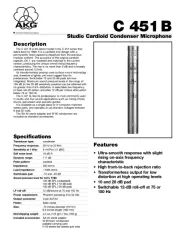
2 Augustus 2025
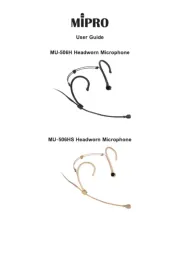
29 Juli 2025
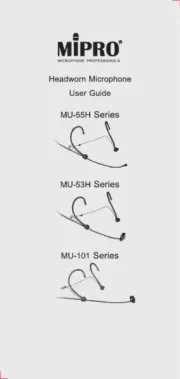
29 Juli 2025
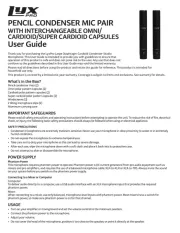
29 Juli 2025

29 Juli 2025
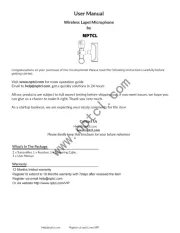
28 Juli 2025
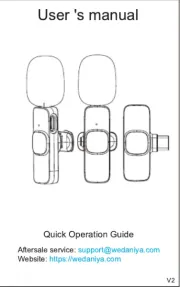
28 Juli 2025
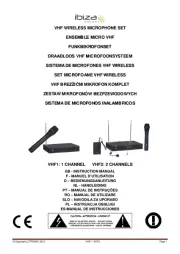
28 Juli 2025
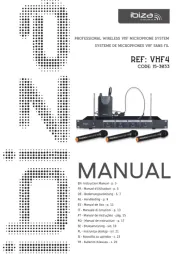
28 Juli 2025
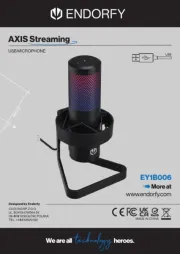
23 Juli 2025